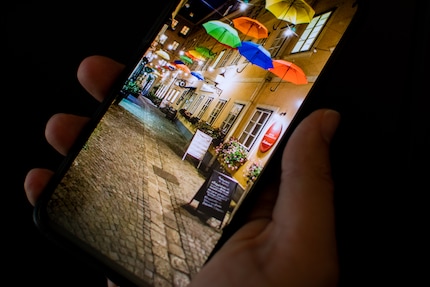
Background information
Yeah, science: how OLEDs work
by Luca Fontana

OLED screens are superior to LCD-based screens. But they have one disadvantage: low brightness. This is mostly due to anti-reflection filters that absorb light. As it seems, researchers from England have now succeeded in solving this problem.
OLED screens are considered the best screens for televisions and smartphones. Why? They’re based on a technology with light emitting diodes – LEDs – which don’t only determine their own colour, but also generate their own light.
Reflective filters are used to prevent reflections on your TV or smartphone screen. But these filters come with a disadvantage: they absorb almost half the light-emitted by OLEDs. For this reason, the light-emitting diodes must shine particularly brightly to allow enough light to pass through the reflective filters.

Now researchers are said to have found a way to solve this efficiency problem. The big advantages: better contrast, longer battery life and less burn-in.
How do OLEDs work? OLEDs are composed of thin films of organic molecules that create light with the application of electricity. Matching colour molecules then provide the colours. «O» in OLED stands for «organic», which means carbon-containing in chemistry.
It is precisely this chemical composition that researchers at Imperial College in London claim to have changed. At least, that’s what Phys.org reports and claims that the team around Dr. Jess Wade has developed a new type of OLED that is able to bypass the reflective filters without any losses by emitting polarised light.
With polarised light, there is no light loss and therefore improved maximum brightness. With simultaneous True Black, this results in even better contrasts and more intense colours than before.
At the same time, less loss of light also means reduced strength of light output. This is why the new OLEDs require much less energy. With a smartphone, for instance, this would result in a significantly longer battery life. Because the lifespan of such displays is doubled at the same time, the risk of burn-in is also reduced.
And there’s more good news: According to the researchers, as Phys.org reports, this technology can be used for other purposes, too: polarised light is said to be suitable for storing, transmitting and encrypting data.
However, the most important question remains unanswered in the studies published in the scientific magazine ACS Nano. This is when the new OLED technology will be built into new OLED televisions and smartphones. I asked them but haven’t received an answer yet.
If you’d like to be informed about more behind-the-scenes news from the world of cinema and TVs, follow me by clicking on the «Follow author» button.
I write about technology as if it were cinema, and about films as if they were real life. Between bits and blockbusters, I’m after stories that move people, not just generate clicks. And yes – sometimes I listen to film scores louder than I probably should.
From the latest iPhone to the return of 80s fashion. The editorial team will help you make sense of it all.
Show all